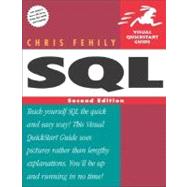As dynamic, database-driven Web sites become the standard, more and more nonprogrammers just like yourself are being forced to work with database information and create and edit database objects. With SQL and this task-based guide to it, you can do it too--no programming experience required!
After going over the relational database model and SQL syntax in the first few chapters, veteran author Chris Fehily launches into the tasks that will get you comfortable with SQL fast. In addition to explaining SQL basics, this updated reference covers the ANSI SQL:2003 standard and contains a wealth of brand-new information, including a new chapter on set operations and common tasks, well-placed optimization tips to make your queries run fast, sidebars on advanced topics, and added IBM DB2 coverage.
Best of all, the book's examples were tested on the latest versions of Microsoft Access, Microsoft SQL Server, Oracle, IBM DB2, MySQL, and PostgreSQL. On the companion Web site, you can download the SQL scripts and sample database for all these systems and put your knowledge to work immediately on a real database..








